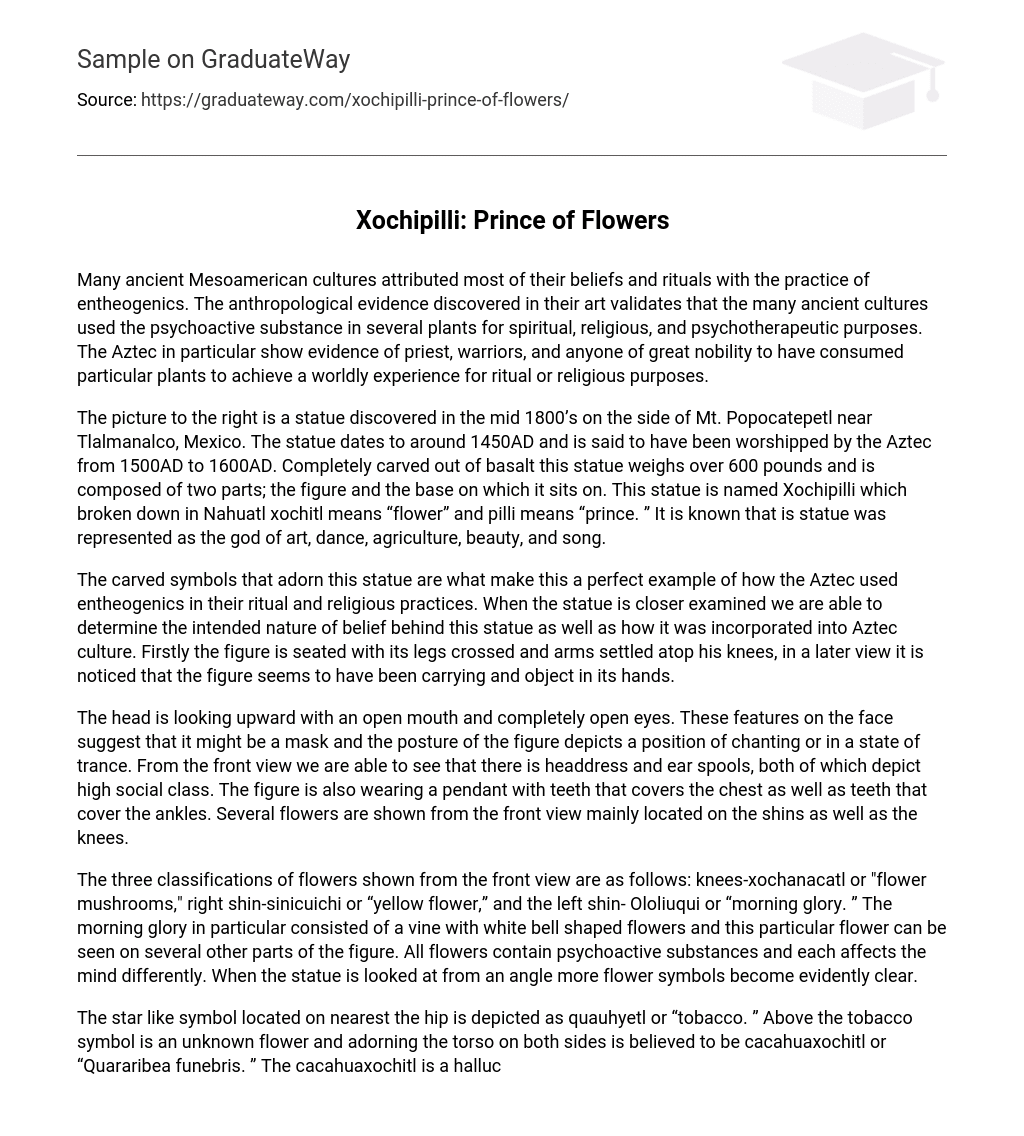Many ancient Mesoamerican cultures attributed most of their beliefs and rituals with the practice of entheogenics. The anthropological evidence discovered in their art validates that the many ancient cultures used the psychoactive substance in several plants for spiritual, religious, and psychotherapeutic purposes. The Aztec in particular show evidence of priest, warriors, and anyone of great nobility to have consumed particular plants to achieve a worldly experience for ritual or religious purposes.
The picture to the right is a statue discovered in the mid 1800’s on the side of Mt. Popocatepetl near Tlalmanalco, Mexico. The statue dates to around 1450AD and is said to have been worshipped by the Aztec from 1500AD to 1600AD. Completely carved out of basalt this statue weighs over 600 pounds and is composed of two parts; the figure and the base on which it sits on. This statue is named Xochipilli which broken down in Nahuatl xochitl means “flower” and pilli means “prince. ” It is known that is statue was represented as the god of art, dance, agriculture, beauty, and song.
The carved symbols that adorn this statue are what make this a perfect example of how the Aztec used entheogenics in their ritual and religious practices. When the statue is closer examined we are able to determine the intended nature of belief behind this statue as well as how it was incorporated into Aztec culture. Firstly the figure is seated with its legs crossed and arms settled atop his knees, in a later view it is noticed that the figure seems to have been carrying and object in its hands.
The head is looking upward with an open mouth and completely open eyes. These features on the face suggest that it might be a mask and the posture of the figure depicts a position of chanting or in a state of trance. From the front view we are able to see that there is headdress and ear spools, both of which depict high social class. The figure is also wearing a pendant with teeth that covers the chest as well as teeth that cover the ankles. Several flowers are shown from the front view mainly located on the shins as well as the knees.
The three classifications of flowers shown from the front view are as follows: knees-xochanacatl or “flower mushrooms,” right shin-sinicuichi or “yellow flower,” and the left shin- Ololiuqui or “morning glory. ” The morning glory in particular consisted of a vine with white bell shaped flowers and this particular flower can be seen on several other parts of the figure. All flowers contain psychoactive substances and each affects the mind differently. When the statue is looked at from an angle more flower symbols become evidently clear.
The star like symbol located on nearest the hip is depicted as quauhyetl or “tobacco. ” Above the tobacco symbol is an unknown flower and adorning the torso on both sides is believed to be cacahuaxochitl or “Quararibea funebris. ” The cacahuaxochitl is a hallucinogen flower and the tobacco was an assistant in enhance the effects of these particular mind altering drugs. The base of the statue is similar in on the all sides excluding the back. The front and sides of are bordered with symbols of jade beads and show the symbol for the xochanacatl or “flower mushroom. On the lower portion of the flower mushroom shows the symbol for a butterfly which appears to be drinking from the flower mushroom. The flower mushrooms were only consumed by the elite for ritualistic experiences and religious communion. The Aztec believed that any warrior who died in combat go through a metamorphosis and turn into a butterfly. One of the most important features on the statue is the headdress that is worn. The entire headdress is lined with feathers Here there are numerical symbols are shown. There are 5 numerical symbols which consist of 4bars.
This associates this figure with the five gods of excess, with Xochipilli being the fifth. The four dots represent the heat of the sun aThe pedestal from the back, although not shown show 3 butterflies of which seem to all be drinking from the mushroom flower. After a total analysis of the statue and all interpreted symbols parlaying its integrated position and reason becomes slightly easier. Xochipilli is also referred to as Macuilxochitl or “five flowers. ” The nature of the figure is not known, whether it resembles a priest wearing a mask or the actual god himself is unknown.
But what is clear is its nature in representation. This statue represented the intoxicating rituals that the Aztec had partaken in. The position of the figure shows embrace. The Aztec embraced the land in which they lived on as well as the plants in which sprung from it. One specific occasion this statue would be celebrated was during the “Farewell to the Flowers,” which the Aztec would celebrate by smelling the flowers that had sprung and honor the flowers to come after the frost season. This particular deity signified the incorporated use of intoxication in Aztec life and was a metaphor for honorable death, poetry, and song.





